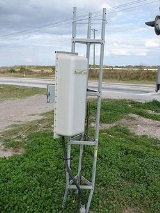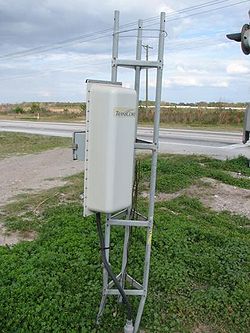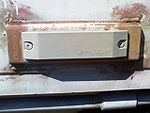
Automatic Equipment Identification
Encyclopedia
Automatic equipment identification (AEI) is an electronic recognition system in use with the North America
n railroad industry. Consisting of passive tags mounted on each side of rolling stock
and active trackside readers, AEI uses RF
technology to identify railroad equipment while en route.

(AAR), a number of companies developed automatic car identification (ACI) systems. The AAR selected four systems for extensive field tests. General Electric developed an RFID system, ABEX a microwave system, Wabco a black and white barcode system, and General Telephone and Electronics (GTE) a color barcode system called KarTrak. The RFID system used a tag mounted under the rail car and an interrogator installed between the rails. The other three systems had labels that were mounted on each side of the rail car and a trackside scanner.
After the initial field tests, the ABEX, Wabco, and the GTE KarTrak ACI systems were selected for a head-to-head accuracy test on the Pennsylvania Railroad, at Spruce Creek PA. The KarTrak system was declared the winner and selected by the AAR as the standard.
Starting in 1968 all railcar owners were required by the AAR to install ACI labels on their cars. This requirement lead to full-scale implementation of the ACI system in the early 1970s. By 1975 90% of all railcars were labeled. The read rate was about 80%, which means that after seven years of service 10% of the labels had failed for reasons such as physical damage and dirt accumulation. The dirt accumulation was most evident on flatcars that had low-mounted labels.
The AAR had recognized from their field tests that periodic inspection and label maintenance would be requirements to maintain a high level of label readability. Regulations were instituted for label inspection and repair whenever a railcar was in the repair shop, which on average happened every two years.
Unfortunately the maintenance program never gained sufficient compliance. Without maintenance the read rate failed to improve, and the KarTrak system was abandoned by the late 1970s. Because of this failure, the railroad industry did not seriously search for another system to identify rail cars until the mid-1980s.
shipping companies, such as American President Lines
, in their efforts to find a system to automatically identify containers. Based on the maritime companies' success with RF-based identification systems, Burlington Northern began a testing program in 1986.
Burlington Northern initially asked nine vendors to present their identification systems. From this group of nine, Burlington Northern selected two systems for full scale testing. The two vendors selected were General Railway Signal
(GRS) and Union Switch & Signal
(US&S). The US&S system is manufactured by Amtech Corporation of Dallas, Texas
.
In January, 1988, Burlington Northern equipped 1,500 taconite
(iron ore pellets) rail cars in northern Minnesota
each with a GRS and an Amtech transponder
. Each vendor also installed three wayside reader sites. All tags were mounted on the sides of the rail cars.
In August, 1988, the Burlington Northern Railroad presented a report on the results of their testing at the AAR Communication and Signal Annual Meeting. They stated that the accuracy of both systems over a six-month period was in excess of 99.99%. Based on the spectacular results from both systems, the Burlington Northern asked the AAR to form a committee to write an AEI standard for the North American rail industry, and suggested that the AAR use the current draft ISO standard for container identification as a starting point.
A committee was formed by the AAR, charged with the development of an AEI standard. Railroads such as Norfolk Southern Railway
, Union Pacific Railroad
, CSX Transportation
and Canadian National Railway
began their own testing programs and reported the results to the AAR's AEI Committee.
In August, 1989, the AAR informed various identification system vendors that Amtech's identification technology had been selected as the AEI standard.
By the fall of 1989, the AAR's AEI Committee had selected a technology and defined the tag's data format. The only major decision that was still unresolved was the location of the tag on the rail car. This became a very controversial subject for the next nine months, as there were two groups of thought. One group wanted to place tags on the sides of the rail cars and another wanted them underneath. Each location had its advantages and disadvantages in terms of cost and maintainability. The tags were tested and found to operate well in both locations. It was finally decided by the AEI Committee in the summer of 1990 that two tags would be mounted on each rail car, one on each side.
 In July, 1990, the AAR Committee on Car Service sent a resolution to the O-T General Committee of the AAR to set a mandatory implementation date when all rail cars in interchange service would be tagged. The O-T General Committee is the highest operating committee within the AAR. The O-T General Committee requested that the AEI Committee perform a cost/benefit analysis on mandatory AEI implementation and recommend an implementation schedule. In October, 1990, the O-T General Committee approved the recommended AEI voluntary standard.
In July, 1990, the AAR Committee on Car Service sent a resolution to the O-T General Committee of the AAR to set a mandatory implementation date when all rail cars in interchange service would be tagged. The O-T General Committee is the highest operating committee within the AAR. The O-T General Committee requested that the AEI Committee perform a cost/benefit analysis on mandatory AEI implementation and recommend an implementation schedule. In October, 1990, the O-T General Committee approved the recommended AEI voluntary standard.
With these recommendations, in August, 1991, the O-T General Committee of the Association of American Railroads voted to make the AEI standard mandatory. The mandatory vote was ratified by the AAR Board of Directors at their meeting in September, 1991. The mandatory period started on 1 March, 1992, and ended on 31 December, 1994. By the end of this period all 1.4 million rail cars in North American interchange service were to be tagged.
As part of the AAR's adoption of a standard based on Amtech technology, AAR required that Amtech license that technology. At the time of the AAR's 1991 mandate, six vendors sold AEI site equipment. Those vendors were US&S, Safetran, Harmon, VideoMasters, CCTC International in partnership with IBM, and Southern Technologies. As of August 2007, only two of these vendors remain, SAIC (formerly VideoMasters) and Southern Technologies.
The most common mistakes during the implementation of RFID in rail are:
– Use of common tags on railcars. Tags must have a MTBF of 20 years or more. It means that the RFID must survive at least the railcar live-time, which is at least 20 years.
– Broken tags are not easily changed in a rail environment, totally different from a warehouse environment. Again, MTBF is the key
– AEI is not just for maintenance purposes. AEI helps a lot on customer service level improvement and operations optimization.
The AAR's S-918 specifications outline ten recommended frequencies ranging from 902.250 to 921.500 MHz, depending on the location of the reading device (in a yard or trackside), with a nominal transmitting power of 2.0 Watts (measured at the transmitter).
http://abramo.s2.com.br/ReleaseTexto.aspx?press_release_id=18748 – AEI System, ALSTOM(Alexandre Nogueira)
North America
North America is a continent wholly within the Northern Hemisphere and almost wholly within the Western Hemisphere. It is also considered a northern subcontinent of the Americas...
n railroad industry. Consisting of passive tags mounted on each side of rolling stock
Rolling stock
Rolling stock comprises all the vehicles that move on a railway. It usually includes both powered and unpowered vehicles, for example locomotives, railroad cars, coaches and wagons...
and active trackside readers, AEI uses RF
Radio frequency
Radio frequency is a rate of oscillation in the range of about 3 kHz to 300 GHz, which corresponds to the frequency of radio waves, and the alternating currents which carry radio signals...
technology to identify railroad equipment while en route.

Predecessor systems
In the late 1960s, railroads in North America began searching for a system that would allow them to automatically identify rail cars and other rolling stock. Through the efforts of the Association of American RailroadsAssociation of American Railroads
The Association of American Railroads is an industry trade group representing primarily the major freight railroads of North America . Amtrak and some regional commuter railroads are also members...
(AAR), a number of companies developed automatic car identification (ACI) systems. The AAR selected four systems for extensive field tests. General Electric developed an RFID system, ABEX a microwave system, Wabco a black and white barcode system, and General Telephone and Electronics (GTE) a color barcode system called KarTrak. The RFID system used a tag mounted under the rail car and an interrogator installed between the rails. The other three systems had labels that were mounted on each side of the rail car and a trackside scanner.
After the initial field tests, the ABEX, Wabco, and the GTE KarTrak ACI systems were selected for a head-to-head accuracy test on the Pennsylvania Railroad, at Spruce Creek PA. The KarTrak system was declared the winner and selected by the AAR as the standard.
Starting in 1968 all railcar owners were required by the AAR to install ACI labels on their cars. This requirement lead to full-scale implementation of the ACI system in the early 1970s. By 1975 90% of all railcars were labeled. The read rate was about 80%, which means that after seven years of service 10% of the labels had failed for reasons such as physical damage and dirt accumulation. The dirt accumulation was most evident on flatcars that had low-mounted labels.
The AAR had recognized from their field tests that periodic inspection and label maintenance would be requirements to maintain a high level of label readability. Regulations were instituted for label inspection and repair whenever a railcar was in the repair shop, which on average happened every two years.
Unfortunately the maintenance program never gained sufficient compliance. Without maintenance the read rate failed to improve, and the KarTrak system was abandoned by the late 1970s. Because of this failure, the railroad industry did not seriously search for another system to identify rail cars until the mid-1980s.
Development
Burlington Northern was the first railroad in North America to renew the search for an effective identification system. BN had been closely following the efforts of various maritimeSea
A sea generally refers to a large body of salt water, but the term is used in other contexts as well. Most commonly, it means a large expanse of saline water connected with an ocean, and is commonly used as a synonym for ocean...
shipping companies, such as American President Lines
American President Lines
American President Lines Ltd. is the world's seventh-largest container transportation and shipping company, providing services to more than 140 countries through a network combining intermodal freight transport operations with IT and e-commerce...
, in their efforts to find a system to automatically identify containers. Based on the maritime companies' success with RF-based identification systems, Burlington Northern began a testing program in 1986.
Burlington Northern initially asked nine vendors to present their identification systems. From this group of nine, Burlington Northern selected two systems for full scale testing. The two vendors selected were General Railway Signal
General Railway Signal
General Railway Signal Company was a supplier of railway signaling equipment, systems and services in the Rochester, New York area. The company was established in 1904 and became part of Alstom Transport in 1998...
(GRS) and Union Switch & Signal
Union Switch & Signal
Union Switch and Signal was a supplier of railway signaling equipment, systems and services in Pittsburgh, Pennsylvania. As of January 1, 2009, US&S is known as Ansaldo STS USA.-History:...
(US&S). The US&S system is manufactured by Amtech Corporation of Dallas, Texas
Dallas, Texas
Dallas is the third-largest city in Texas and the ninth-largest in the United States. The Dallas-Fort Worth Metroplex is the largest metropolitan area in the South and fourth-largest metropolitan area in the United States...
.
In January, 1988, Burlington Northern equipped 1,500 taconite
Taconite
Taconite is a variety of iron formation, an iron-bearing sedimentary rock, in which the iron minerals are interlayered with quartz, chert, or carbonate...
(iron ore pellets) rail cars in northern Minnesota
Minnesota
Minnesota is a U.S. state located in the Midwestern United States. The twelfth largest state of the U.S., it is the twenty-first most populous, with 5.3 million residents. Minnesota was carved out of the eastern half of the Minnesota Territory and admitted to the Union as the thirty-second state...
each with a GRS and an Amtech transponder
Transponder
In telecommunication, the term transponder has the following meanings:...
. Each vendor also installed three wayside reader sites. All tags were mounted on the sides of the rail cars.
In August, 1988, the Burlington Northern Railroad presented a report on the results of their testing at the AAR Communication and Signal Annual Meeting. They stated that the accuracy of both systems over a six-month period was in excess of 99.99%. Based on the spectacular results from both systems, the Burlington Northern asked the AAR to form a committee to write an AEI standard for the North American rail industry, and suggested that the AAR use the current draft ISO standard for container identification as a starting point.
A committee was formed by the AAR, charged with the development of an AEI standard. Railroads such as Norfolk Southern Railway
Norfolk Southern Railway
The Norfolk Southern Railway is a Class I railroad in the United States, owned by the Norfolk Southern Corporation. With headquarters in Norfolk, Virginia, the company operates 21,500 route miles in 22 eastern states, the District of Columbia and the province of Ontario, Canada...
, Union Pacific Railroad
Union Pacific Railroad
The Union Pacific Railroad , headquartered in Omaha, Nebraska, is the largest railroad network in the United States. James R. Young is president, CEO and Chairman....
, CSX Transportation
CSX Transportation
CSX Transportation operates a Class I railroad in the United States known as the CSX Railroad. It is the main subsidiary of the CSX Corporation. The company is headquartered in Jacksonville, Florida, and owns approximately 21,000 route miles...
and Canadian National Railway
Canadian National Railway
The Canadian National Railway Company is a Canadian Class I railway headquartered in Montreal, Quebec. CN's slogan is "North America's Railroad"....
began their own testing programs and reported the results to the AAR's AEI Committee.
In August, 1989, the AAR informed various identification system vendors that Amtech's identification technology had been selected as the AEI standard.
By the fall of 1989, the AAR's AEI Committee had selected a technology and defined the tag's data format. The only major decision that was still unresolved was the location of the tag on the rail car. This became a very controversial subject for the next nine months, as there were two groups of thought. One group wanted to place tags on the sides of the rail cars and another wanted them underneath. Each location had its advantages and disadvantages in terms of cost and maintainability. The tags were tested and found to operate well in both locations. It was finally decided by the AEI Committee in the summer of 1990 that two tags would be mounted on each rail car, one on each side.

With these recommendations, in August, 1991, the O-T General Committee of the Association of American Railroads voted to make the AEI standard mandatory. The mandatory vote was ratified by the AAR Board of Directors at their meeting in September, 1991. The mandatory period started on 1 March, 1992, and ended on 31 December, 1994. By the end of this period all 1.4 million rail cars in North American interchange service were to be tagged.
As part of the AAR's adoption of a standard based on Amtech technology, AAR required that Amtech license that technology. At the time of the AAR's 1991 mandate, six vendors sold AEI site equipment. Those vendors were US&S, Safetran, Harmon, VideoMasters, CCTC International in partnership with IBM, and Southern Technologies. As of August 2007, only two of these vendors remain, SAIC (formerly VideoMasters) and Southern Technologies.
Usage
As of 31 December, 1994, Amtech had shipped over 3.1 million tags to railways in North America. The AAR reported that over 95% of the North American rail car fleeted was tagged. Over 3,000 readers have been installed by the railways in North America as of the end of 2000. Amtech was bought by TransCore. TransCore is today the most important producer of RFID tags for rail in the world.The most common mistakes during the implementation of RFID in rail are:
– Use of common tags on railcars. Tags must have a MTBF of 20 years or more. It means that the RFID must survive at least the railcar live-time, which is at least 20 years.
– Broken tags are not easily changed in a rail environment, totally different from a warehouse environment. Again, MTBF is the key
– AEI is not just for maintenance purposes. AEI helps a lot on customer service level improvement and operations optimization.
The AAR's S-918 specifications outline ten recommended frequencies ranging from 902.250 to 921.500 MHz, depending on the location of the reading device (in a yard or trackside), with a nominal transmitting power of 2.0 Watts (measured at the transmitter).
External links
- ACI A description of the earlier ACI barcode systemBarcode systemA barcode system is a network of hardware and software, consisting primarily of mobile computers, printers, handheld scanners, infrastructure, and supporting software. Barcode systems are used to automate data collection where hand recording is neither timely or cost effective...
http://abramo.s2.com.br/ReleaseTexto.aspx?press_release_id=18748 – AEI System, ALSTOM(Alexandre Nogueira)

